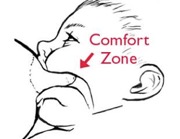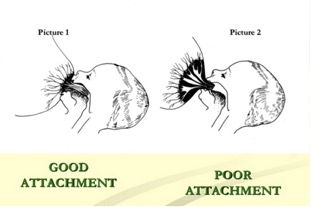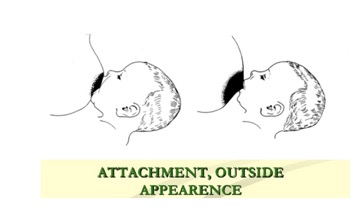A baby’s first year of life is amazing in terms of growth—and a growing appetite! Knowing what to expect helps mother relax more and enjoy breastfeeding.
When you are starting your breastfeeding journey it may be difficult to imagine what it will be like tomorrow let alone next week or next month! Babies change so quickly and so do their needs and schedules. Knowing what to expect will help you navigate this journey so you are not surprised!
Baby’s Stomach Size in First 10 Days
Many moms fear they are not producing enough milk when their baby is first born, and that can be scary! But knowing that a newborn baby’s stomach is the size of a shooter marble can hopefully alleviate some of those fears. Imagine how small a shooter marble is! Your body is all set to provide that nourishment in the form of colostrum. By day 3 your baby’s stomach is the size of a ping pong ball. Compared to a shooter marble, bigger, but still something you and your body can handle! By day 10 your baby’s stomach is the size an extra large chicken egg. Relax and enjoy this time, trusting that your body knows what to do! See below for a baby stomach size chart:
Birth to Day 4, everything is new and you are both learning!Â
The Facts
- A newborn’s stomach is as small as a shooter marble. At birth, you have just the right amount of milk to fill it.
- Your breasts are never empty.
- When breastfeeding well, newborns usually do better without water or formula.
- Lots of breastfeeding brings in more milk faster.
- Most mothers start to make much more milk starting on day 3 or 4.
- Lots of breastfeeding helps prevent engorged breasts.
- Most mothers can make enough milk for twins, triplets, and more.
- Keep your baby on your body skin to skin for easier feedings and increased milk production.
What to Expect
- Lots of breastfeeding.
- Your nipple may feel tender for the first minute or two of nursing then feel better.
- If your baby fusses, offer each breast more than once.
- Expect 1-2 wet diapers each day and sticky, black stools through day 2 turning to a less sticky and brown stool.
- Many newborns lose up to 10% of birth weight by Day 4.
- There may be no pattern or schedule to feedings, and babies generally feed more often during the moon hours versus the sun hours. This is normal.
Things to Learn
- Try breastfeeding lying down with baby belly down on your body, so you can breastfeed and rest.
- For greater comfort, help your baby latch deeply onto your breast. If it hurts, ask for help.
- Make sure your baby feeds at least 8 times a day. Feedings may be bunched together. If needed, guide baby to breast while drowsy and in a light sleep.
- Ask where you can get breastfeeding help if needed.
Day 4 to 6 weeks is all about establishing your milk production!
The Facts
- A baby’s stomach stretches to the size of a chicken egg by Day 10.
- Most babies feed 8-12 times a day but not at set times. They may bunch feedings close together for part of the day or night.
- Babies may take one breast at a feeding, or they may need to feed from both breasts. Let your baby decide.
- More breastfeeding makes more milk.
- Most mothers start to make much more milk starting on day 3 or 4.
- Drained breasts make milk faster. Full breasts make milk slower.
- Breastfeed only. Avoid pacifiers until your baby is latching and breastfeeding well. If your baby is breastfeeding well, no additional liquids are needed unless recommended by your healthcare provider.
What to Expect
- If your breasts feel very full, breastfeed more or express milk. This will make you feel better, not worse.
- Baby’s stool to start turning from brown to yellow around day 3 or 4. Expect 3-4 or more yellow, runny, seedy looking stools every day. However, every baby’s bowel pattern is different.
- Expect 5-6 or more wet diapers a day by Day 5.
- Your baby should be back to birth weight by 2 weeks.
- Your baby may want to feed again soon after breastfeeding. This is normal now. Your breasts still have milk.
- She wakes a lot at night. (Babies need to do this to get enough milk.)
- Some babies sleep for one 4-5 hour stretch each day. It may not be at night.
Things to Learn
- Breastfeed whenever your baby wants to. You’ll know it’s time when your baby turns her head from side to side with an open mouth or when she puts her hand to her mouth.
- Don’t wait until your baby fusses or cries. When upset, it’s harder to feed well.
- Use breastfeeding positions that feel good for you and your baby.
- If breastfeeding hurts, get help. A small change in how your baby takes the breast may be all you need to feel better.
- Find a mothers group near you. Spend time with other breastfeeding mothers.
6 Weeks to 6 Months, reaching your groove
The Facts
- Your baby’s stomach size is larger and holds more milk. She may feed less often.
- Most mothers no longer feel full, even with lots of milk.
- Babies need about as much milk per day at 6 weeks as 6 months.
- Now breastfeeding starts to take less time than bottle-feeding.
- When breastfeeding well, a baby does best on mother’s milk alone until about 6 months.
What to Expect
- Older babies are faster feeders. The baby who used to feed 40 minutes may now be done in 10-15 minutes.
- Some babies this age have fewer stools but gain weight just fine.
- Older babies may pull off the breast, distracted or curious by sights and sounds.
Things to Learn
- Trust your baby to know the right time to feed.
- Practice breastfeeding when away from home until you feel at ease. Even when breastfeeding is going well, you may experience some of the following:
- Your baby has fussy times. (Most babies do, and it is not always about food!)
- She wants to feed again soon after breastfeeding. (Most babies do.)
- She wants to feed more often. (This adjusts your milk production.)
- Your breasts no longer feel full. (Usually at around 6 weeks.)
- She wants to feed less often or for a shorter time. (Babies get faster with practice.)
- She may wake up less often at night the older she gets, but if she continues to wake up that is normal.
To learn more about breast pumping and breastfeeding, check out these articles:
- Benefits of Breastfeeding Â
- Breastfeeding Problems and Solutions
- Dad’s Role in Breastfeeding
- Breast Pumping Guide: When and How Long to Pump
- Latching And Breastfeeding Positions
- Breast Milk Storage Guidelines: How To Store Breast Milk Safely






